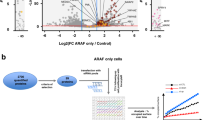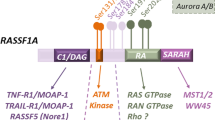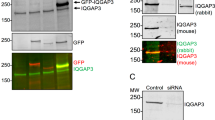Abstract
The Raf-MEK-ERK protein kinase cascade is a highly conserved signaling pathway that is pivotal in relaying environmental cues from the cell surface to the nucleus. Three Raf isoforms, which share great sequence and structure similarities, have been identified in mammalian cells. We have previously identified Raf kinase inhibitor protein (RKIP) as a negative regulator of the Raf-MEK-ERK signaling pathway by specifically binding to the Raf-1 isoform. We show here that RKIP also antagonizes kinase activity of the B-Raf isoform. Yeast two-hybrid and coimmunoprecipitation experiments indicated that RKIP specifically interacted with B-Raf. Ectopic expression of RKIP antagonized the kinase activity of B-Raf. We showed that the effects of RKIP on B-Raf functions were independent of its known inhibitory action on Raf-1. The expression levels of RKIP in melanoma cancer cell lines are low relative to primary melanocytes. Forced expression of RKIP partially reverted the oncogenic B-Raf kinase-transformed melanoma cancer cell line SK-Mel-28. The low expression of RKIP and its antagonistic action on B-Raf suggests that RKIP may play an important role in melanoma turmorgenesis.
This is a preview of subscription content, access via your institution
Access options
Subscribe to this journal
Receive 50 print issues and online access
$259.00 per year
only $5.18 per issue
Buy this article
- Purchase on Springer Link
- Instant access to full article PDF
Prices may be subject to local taxes which are calculated during checkout



Similar content being viewed by others
References
Carr J and Mackie RM . (1994). Br. J. Dermatol., 131, 72–77.
Chatterjee D, Bai Y, Wang Z, Beach S, Mott S, Roy R, Braastad C, Sun Y, Mukhopadhyay A, Aggarwal BB, Darnowski J, Pantazis P, Wyche J, Fu Z, Kitagwa Y, Keller ET, Sedivy JM and Yeung KC . (2004). J. Biol. Chem., 279, 17515–17523.
Cowley S, Paterson H, Kemp P and Marshall CJ . (1994). Cell, 77, 841–852.
Davies H, Bignell GR, Cox C, Stephens P, Edkins S, Clegg S, Teague J, Woffendin H, Garnett MJ, Bottomley W, Davis N, Dicks E, Ewing R, Floyd Y, Gray K, Hall S, Hawes R, Hughes J, Kosmidou V, Menzies A, Mould C, Parker A, Stevens C, Watt S, Hooper S, Wilson R, Jayatilake H, Gusterson BA, Cooper C, Shipley J, Hargrave D, Pritchard-Jones K, Maitland N, Chenevix-Trench G, Riggins GJ, Bigner DD, Palmieri G, Cossu A, Flanagan A, Nicholson A, Ho JW, Leung SY, Yuen ST, Weber BL, Seigler HF, Darrow TL, Paterson H, Marais R, Marshall CJ, Wooster R, Stratton MR and Futreal PA . (2002). Nature, 417, 949–954.
Hagemann C and Rapp UR . (1999). Exp. Cell Res., 253, 34–46.
Hingorani SR, Jacobetz MA, Robertson GP, Herlyn M and Tuveson DA . (2003). Cancer Res., 63, 5198–5202.
Huser M, Luckett J, Chiloeches A, Mercer K, Iwobi M, Giblett S, Sun XM, Brown J, Marais R and Pritchard C . (2001). EMBO J., 20, 1940–1951.
Kolch W . (2000). Biochem. J., 351 (Part 2), 289–305.
Mercer K, Chiloeches A, Huser M, Kiernan M, Marais R and Pritchard C . (2002). Oncogene, 21, 347–355.
Mercer KE and Pritchard CA . (2003). Biochim. Biophys. Acta, 1653, 25–40.
Mermelstein F, Yeung K, Cao J, Inostroza JA, Erdjument-Bromage H, Eagelson K, Landsman D, Levitt P, Tempst P and Reinberg D . (1996). Genes Dev., 10, 1033–1048.
Mikula M, Schreiber M, Husak Z, Kucerova L, Ruth J, Wieser R, Zatloukal K, Beug H, Wagner EF and Baccarini M . (2001). EMBO J., 20, 1952–1962.
Rubinson DA, Dillon CP, Kwiatkowski AV, Sievers C, Yang L, Kopinja J, Rooney DL, Ihrig MM, McManus MT, Gertler FB, Scott ML and Van Parijs L . (2003). Nat. Genet., 33, 401–406.
Sumimoto H, Miyagishi M, Miyoshi H, Yamagata S, Shimizu A, Taira K and Kawakami Y . (2004). Oncogene, 23, 6031–6039.
Wan PT, Garnett MJ, Roe SM, Lee S, Niculescu-Duvaz D, Good VM, Jones CM, Marshall CJ, Springer CJ, Barford D and Marais R . (2004). Cell, 116, 855–867.
Weber CK, Slupsky JR, Kalmes HA and Rapp UR . (2001). Cancer Res., 61, 3595–3598.
Wellbrock C, Ogilvie L, Hedley D, Karasarides M, Martin J, Niculescu-Duvaz D, Springer CJ and Marais R . (2004). Cancer Res., 64, 2338–2342.
Yeung K, Janosch P, McFerran B, Rose DW, Mischak H, Sedivy JM and Kolch W . (2000). Mol. Cell. Biol., 20, 3079–3085.
Yeung K, Seitz T, Li S, Janosch P, McFerran B, Kaiser C, Fee F, Katsanakis KD, Rose DW, Mischak H, Sedivy JM and Kolch W . (1999). Nature, 401, 173–177.
Zhang BH and Guan KL . (2000). EMBO J., 19, 5429–5439.
Acknowledgements
We thank K-L Guan and William Maltese for plasmid constructs, M Baccarini for the Raf-1−/− MEF cells. We also thank John Sedivy for his continued support and Walter Kolch for sharing results on RKIP expression in melanoma before publication. This work was supported by NIH grants to KCY (R01 GM64767).
Author information
Authors and Affiliations
Corresponding author
Rights and permissions
About this article
Cite this article
Park, S., Yeung, M., Beach, S. et al. RKIP downregulates B-Raf kinase activity in melanoma cancer cells. Oncogene 24, 3535–3540 (2005). https://doi.org/10.1038/sj.onc.1208435
Received:
Revised:
Accepted:
Published:
Issue Date:
DOI: https://doi.org/10.1038/sj.onc.1208435
Keywords
This article is cited by
-
Development of a yeast-based system to identify new hBRAFV600E functional interactors
Oncogene (2019)
-
Overexpression of RKIP and its cross-talk with several regulatory gene products in multiple myeloma
Journal of Experimental & Clinical Cancer Research (2017)
-
Role of Raf-kinase inhibitor protein in colorectal cancer and its regulation by hydroxycamptothecine
Journal of Biomedical Science (2015)
-
Quantitative proteomic analysis shows differentially expressed HSPB1 in glioblastoma as a discriminating short from long survival factor and NOVA1 as a differentiation factor between low-grade astrocytoma and oligodendroglioma
BMC Cancer (2015)
-
Central role of Snail1 in the regulation of EMT and resistance in cancer: a target for therapeutic intervention
Journal of Experimental & Clinical Cancer Research (2014)



